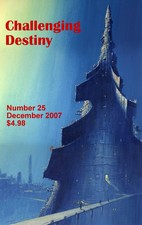


Reviews Home
Columns
Fiction by Title
Fiction by Author
Nonfiction
Movies by Title
Movies by Rating
Audio
Games
Trapped, James Alan Gardner, Eos, 2002, 382 pp.
Trapped is James Alan Gardnerís sixth novel; it takes place in the same universe and future as his earlier works, but like his second novel, Commitment Hour, it doesnít reference any of the recurring characters in the other four books. Trapped resembles Commitment Hour in a few other ways: both are set on Earth, in a time period when most of humanity have left to join the galactic civilization known as the League of Peoples. Human-based progress has stopped centuries ago, and thereís not much of OldTech, as itís known, still functioning. The League of Peoples only lets sentient people out of their solar system, and by sentient they mean someone who is not a murderer. This has interesting implications for those who are on planet Earth, by choice or by inheritance.
Itís actually a fairly durable theme. Gardner used the idea of the abandoned society in Commitment Hour to examine gender roles and the nature of adolescence in the face of mutability of identity. This book has its own take on the subject, which I will discuss more in a minute. Other books to use the idea include Iain Banksí Feersum Endjinn, which posited many interesting notions about information spaces, cultural decay, and what the ignorant would do in the case of a celestial emergency millennia after the space-farers have left. Another example might be Vernor Vingeís Marooned in Realtime, in which the act of leaving was an example of Vingeís concept of the singularity; those still on Earth have no clue what happened to those who hit a certain parabola of progress. Other examples exist, and interestingly, they are all quite different in their intent.
Gardnerís Trapped seems to use this milieu in the pursuit of the one of the most famous clichés in the genre, Arthur C. Clarkeís dictum about the surface similarities between advanced science and magic. The League of Peoples have gifted those left on Earth with powers that are almost exactly modelled on historical notions of mental powers, like telepathy, telekinesis, and so forth. The characters in the book have an explanation of what is going on -- it has something to do with nanotechnology -- but they have no hope of doing anything with that knowledge. They can apprehend, but not act. This keen sense of powerlessness pervades the book. Whatís worse, in the face of unequal distribution of these mental powers, the villainous elements on Earth have a tendency to enslave those who have the powers in abundance, for profit or other nefarious ends.
The story of Trapped follows a protagonist named Philemon Abu Dhubhai, who narrates the book. Phil, as he is known to his friends, teaches at a private school for rich kids, mainly rich kids who couldnít get into better schools. He and his friends are all teachers at the academy; the first chapter follows them on a night of heavy drinking as they try to drown out their sense of their own mediocrity. But the plot soon kicks into high gear as one member of the group, the Caryatid, has one of her well-known premonitions. This particular foreboding indicates that they will soon be going on a quest. Later that night, Phil finds out that one of his students, a girl named Rosalind, has been murdered in her bed and Rosalindís boyfriend Sebastian is missing. As it turns out, Sebastian and Rosalind were planning to elope; Sebastian still thinks this is happening because a shapeshifting alien may have murdered Rosalind and taken her place. The plot gets further complicated by the fact that Rosalindís mother is the leader of an infamous gang of criminals, the Ring of Knives. Once she finds out, she is convinced that the teachers are lying to her about the shapeshifting alien. Worse, Sebastian may possess a number of strong mental powers, bringing him to the interest of the current rulers of Earth, the Spark Lords. The teachers soon meet a Spark Lord named Dreamsinger, who treats them like dirt and uses her mind to cause several people to explode into little pieces. Several other unexpectedly bloody events happen before the book comes to its intricately plotted conclusion.
Apart from some overly violent sequences, Trapped displays Gardnerís breezy tone and effortless grasp of humour. So we get this vivid line: ďTime travel always gives respectable physicists the screamie-weamiesĒ (88). Or a section later in the book when we find out what horses think of whatís left of OldTech music. Gardner also uses this light tone to convey some fairly heavy technological speculation, notably about nanotechnology. The book is not ground-breaking in its use of scientific ideas, but everything is used consistently and in a believable context.
Trapped is another interesting and likable book from James Alan Gardner. Worth reading.
Last modified: January 23, 2003
Copyright © 2003 by James Schellenberg

Buy back issues of Challenging Destiny online from:
For the latest information on availability: Where Can You Buy Challenging Destiny?